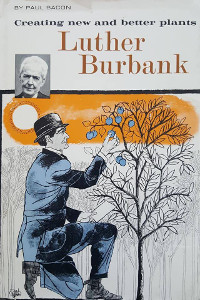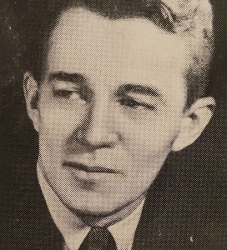Creating New and Better Plants: Luther Burbank

Author:
Paul Bacon
Illustrator:
Don Siculan
Publication:
1961 by Encyclopædia Britannica Press
Genre:
Biography, Non-fiction
Series:
Britannica Bookshelf: Great Lives for Young Americans / Compton Bookshelf: Great Lives / Bookshelf for Young Americans ![]() Members Only
Members Only
Pages:
190
Current state:
This book has been evaluated and information added. It has not been read and content considerations may not be complete.
Book Guide
Search for this book used on:
"I shall be contented if because of me, there shall be better fruits and fairer flowers." This was the aim of fifty years of toil by Luther Burbank in his experimental gardens at Santa Rosa, California. He was not interested in scientific theories about plant growth, but in seeing that each garden should have more and better varieties of cultivated plants in years to come.
Burbank began learning about plants by tending his mother's garden on the family farm in Massachusetts. At the age of 21 he bought some land of his own and raised vegetables for market. Quite by chance he ran across a rare seed ball on one of his potato plants. He planted the seeds from the ball, and from some of them came a new variety of plant, later named the Burbank potato. It was the beginning of his career as a plant inventor.
A few years later he left New England for California where the warm climate enabled him to conduct experiments all year long. He described Santa Rosa in a letter to his mother as "the chosen spot of all this earth as far as nature is concerned."
There was little scientific data on plant breeding available when Burbank began his work, so Nature became his teacher. He did read Charles Darwin's Variations of Animals and Plants under Domestication and everything else he could find by or about Darwin. A confirmed believer in Darwin's theories, he worked on Darwinian concepts. He conducted experiments on a grand scale—as nature does—utilizing thousands upon thousands of plants.
Through hybridization, he produced over 800 new strains and varieties of fruits, flowers, vegetables, grains, grasses, and trees. His "new creations", as he referred to his plants, ranged from the famous Shasta daisy to giant walnut trees and cactus plants without spines. During his lifetime he was considered a wizard, one of the three greatest men in America—along with Thomas Edison and Henry Ford.
Some years after Burbank's death his gardens were restored and opened to the public. But his creations are not confined to his own gardens. It would be difficult to find a garden in the world which does not display some beautiful example of his work.
From the dust jacket
To view an example page please sign in.
Content Guide
Please sign in to access all of the topics associated with this book and view other books with the same topics.
Please sign in to access the locations this book takes place in and view other books in the same location.
Please sign in to access the time periods this book takes place in and view other books in the same time period.
For information about the lead characters please sign in.
Please sign in to access information about the content of this book that you may want to consider before reading.
Find This Book
Search for this book used on:



